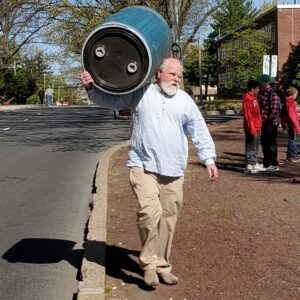Meet LRWP Board Member Alex Zakrewsky!
Interview conducted by Rutgers Spring 2024 Intern Maxim Pavon
Maxim Pavon: What is your earliest or most impactful memory with the Raritan (watershed)?
Alex Zakrewsky: Having grown up in the Raritan River Watershed, I have many boyhood memories of playing in its tributaries. As a free-range kid, my buddies and I would often walk unescorted to local streams to fish, turn over rocks to find crawdads, and build temporary stone and mud dams across rivulets. Hours would pass like minutes as we were totally engrossed in observing and interacting with the moving water and the plants and animals it supported. Sometimes a misstep (a “soaker” in our vernacular) would muddy my sneakers, socks, and pants—earning me a stern scolding from my mother when I eventually arrived home!
MP: At that time, did the people around you, friends and family, see what you saw in the watershed?
AZ: I was not unique in my explorations of the watershed. It was quite common for the working-class boys in my neighborhood (and there were many of us- we were on the tail-end of the baby boom, after all) to entertain ourselves by romping in the stream-side woods. Some would try to make some money by trapping muskrats, then skinning and selling their pelts to Schwendeman’s, a taxidermist and fur broker on Main Street in Milltown. My friends and I sometimes harvested cattails, dried them in the summer sun, and sold them to boutiques for sale as decorative displays. Otherwise, dried cattails (or “punks” as we called them) would make excellent slow-burning lighters for firecrackers on the fourth of July. On other occasions, my friends and I would cut 10-foot-tall bulrushes for use as “lances” as we “jousted” on our bicycles. These were mostly activities for boys and young men, however. Young ladies stayed away, and older men were too busy working in the many factories that dotted the riverbanks.
MP: Throughout your life, who or what has been a continuing source of inspiration for you to pursue the path you are on?
AZ: I am at heart a family man, and I do what I can to support my family. My wife Heather Fenyk is a continuing source of inspiration in her role as LRWP President—her work ethic and effort in this non-paid position is a sight to behold!
MP: What do you hope to accomplish/implement as a Principal Planner with Middlesex County?
AZ: I work with a team of Professional Planners and Licensed Civil Engineers to enhance safety, accessibility, and drainage along County Road rights-of-way.
MP: As Co-founder of Middlesex Apartments, LLC. How has the business’s mission fit in the scope of the watershed?
AZ: Part of the Middlesex Apartments, LLC property portfolio consists of a farm in Princeton, which lies in the Raritan River basin. We are currently exploring restoration of the wetlands on the property, improving the quality of runoff first into the Millstone River, a tributary to the Raritan. We also manage the farm sustainably. This includes using solar for energy, farming without using pesticides and herbicides, letting the goats (instead of mowers) keep the brush down, etc.
MP: As far as the LRWP goes, what has been the biggest hurdle?
AZ: As an organization that has no paid staff, the workload is always vastly greater than the resources available to do the work.
MP: Where have you seen the most growth?
AZ: Since its inception the LRWP has tripled the size of its Board of Directors, and with very accomplished and qualified members. Activities have grown beyond the original stream clean-ups to encompass public boat builds, a wide variety of kinetic and visual artistic displays, water quality monitoring, river tours, kayak floats, presentations, lectures, and numerous and sundry outreach efforts. Revenue from donations and grants has also grown and continues to expand at double-digit rates.
MP: What is something you can tell the people who don’t believe in the LRWP’s mission?
AZ: I would remind them that improving the health of the watershed also brings benefits to them and their families. Our own health and sense of well-being is inextricably tied to the health of the watershed’s ecosystem.
MP: We would also like to get to know the real you! Do you have any hobbies that have nothing to do with watersheds?
AZ: I think I read more than the average person—mostly current periodicals, but also books on historical topics. In recent years I’ve become a fan of YouTube—I like to listen to experts in various fields including anthropology, sociology, philosophy, economics, geopolitics, and military affairs. I also have a keen interest in matters demographic. I developed a model that estimates and predicts the movement of the United States Population Centroid. My annual calculation and commentary on changing US settlement patterns is reported upon in the national and international press.

